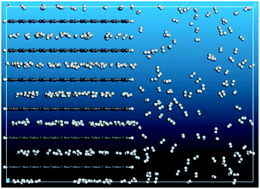Ultimate H2 and CH4 adsorption in slit-like carbon nanopores at 298 K: a molecular dynamics study
Abstract
Hydrogen and methane adsorption is studied on a range of nanoscale carbon slit pores up to 1000 bar at 298 K using molecular dynamics. Past about 200 bar, the calculated adsorbed hydrogen density increases as a function of pressure at the same rate as the highly compressed bulk liquid and thus no saturation plateau is predicted under these conditions. This behaviour implies a continuous increase of the adsorbed hydrogen density past the normal boiling point value and explains high pressure experimental hydrogen adsorption data at 298 K on porous carbons, such as AX-21 activated carbon. This result is put into perspective by comparing with the adsorbed hydrogen phase measured at 50 K on AX-21, which exhibits an ideal incompressible liquid behaviour and a maximum density of only 0.06 g mL−1. These findings therefore suggest the existence of two distinct temperature dependent saturation regimes, most likely of quantum origin. The volumetric capacities show that the adsorbents provide no gains over compression past 600 bar at about 0.04 g mL−1. Conversely, gravimetric capacities inferior to 0.03 g g−1 found below 200 bar indicate large mass penalties when significant gains over compression are achieved. The calculated adsorbed methane density reaches at about 50 bar a true saturation plateau comparable to the pressurized bulk liquid at lower temperatures. Large volumetric and gravimetric capacities of about 365 v v−1 and 0.21 g g−1, respectively, are found in these conditions. These results therefore indicate an interesting 10 fold improvement over compression and a small mass penalty for methane adsorbed on well compacted engineered materials.


 Please wait while we load your content...
Please wait while we load your content...